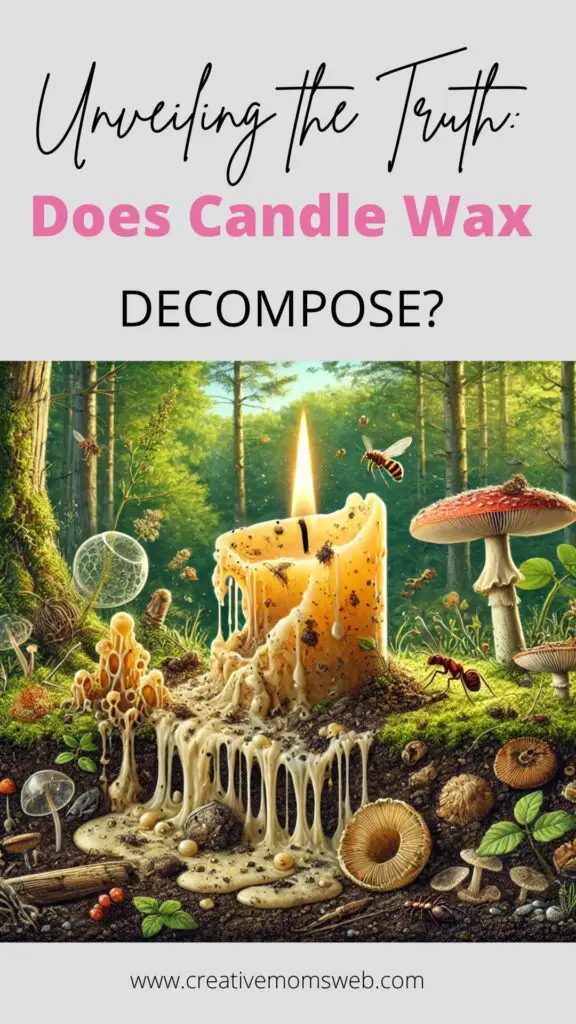Candles create an ambiance of warmth and relaxation, but what happens to the wax once the flame is extinguished? Does candle wax decompose naturally or persist in the environment? In this blog post, we will delve into the world of candle wax and explore its fate after use. We’ll examine different types of candle wax and shed light on their decomposition process, providing insights into the environmental impact of candle waste.

What Is Candle Wax Made Of?
To understand whether candle wax decomposes, it’s crucial to know what it’s made from. Common types of candle wax include:
- Paraffin Wax
- Derived from petroleum, a non-renewable fossil fuel.
- Non-biodegradable and takes a long time to break down.
- Soy Wax
- Made from hydrogenated soybean oil.
- Biodegradable and decomposes faster than paraffin.
- Beeswax
- A natural byproduct of bees.
- Biodegradable and compostable under the right conditions.
- Palm Wax
- Derived from palm oil.
- Biodegradable, but its environmental impact depends on sustainable sourcing.
- Blended Waxes
- Mixtures of various wax types.
- Decomposition depends on the specific blend.
Does Candle Wax Decompose Naturally?
The decomposition of candle wax depends on its type:
- Paraffin Wax
- As a petroleum product, paraffin wax is not biodegradable.
- It may break down into smaller particles over decades, but it doesn’t fully decompose.
- Improper disposal can contribute to environmental pollution.
- Natural Waxes (Soy, Beeswax, Palm)
- These waxes are biodegradable and decompose in natural environments under the right conditions.
- The process is faster when exposed to heat, moisture, and microorganisms.
Factors That Affect Candle Wax Decomposition
- Type of Wax
- As discussed, natural waxes decompose more easily than paraffin.
- Environmental Conditions
- Warmth, humidity, and the presence of microbes accelerate decomposition.
- Additives in Wax
- Fragrance oils, dyes, and other additives can slow the process or leave behind non-biodegradable residues.
- Size and Thickness
- Smaller, thinner wax pieces decompose faster than large chunks.
How Long Does It Take for Candle Wax to Decompose?
The decomposition timeline varies:
- Paraffin Wax: Can take decades or longer due to its petroleum-based nature.
- Soy Wax: May decompose within a few months to a couple of years under optimal conditions.
- Beeswax: Typically decomposes within a year in composting conditions.
- Palm Wax: Decomposition depends on its processing but generally breaks down faster than paraffin.
Eco-Friendly Candle Alternatives
If you’re concerned about the environmental impact of candle wax, consider these alternatives:
- Choose Natural Waxes
Opt for candles made of soy, beeswax, or sustainably sourced palm wax. - Avoid Additives
Look for candles with minimal or no synthetic fragrances and dyes. - Reuse Candle Wax
While candle wax itself may not be widely recyclable due to its mixed composition, there are opportunities for recycling or upcycling other candle components. For instance, glass containers can be recycled, and leftover wax can be reused for new candles or repurposed for other creative projects. Melt down leftover wax to create new candles, wax melts, or fire starters. Read: Various methods What to do with old candle wax - Compost Beeswax
Small pieces of beeswax can be added to your compost pile to biodegrade naturally.

Responsible Disposal Practices:
To minimize the environmental impact of candle wax, it’s essential to adopt responsible disposal practices. Allow the wax to solidify completely before scraping it out of the container. Remove any non-organic components, such as wicks or metal bases, and dispose of them properly. For natural waxes, consider composting them along with other organic materials, as they can break down naturally.
Conclusion: While the decomposition of candle wax varies depending on its type, it’s important to adopt responsible disposal practices to minimize environmental impact. Natural waxes like soy and beeswax offer more sustainable alternatives as they can biodegrade over time. By understanding the fate of candle wax and making informed choices, we can contribute to a greener and more environmentally conscious approach to candle use.
Shop My Favorite Essentials for Candle Making: A Complete Guide for Stay-at-Home Moms
Candle making is a fantastic hobby that allows stay-at-home moms to tap into their creativity, relax, and even start a small business. Whether you’re a beginner or looking to refine your skills, having the right tools and materials is essential. Here’s a list of must-have candle making supplies available on Amazon to get you started. Each item includes a specific product example to make your shopping easier.
1. Wax
Wax is the foundation of any candle. Different types of waxes like soy, beeswax, and paraffin have their unique benefits.
Recommended Product:
- NatureWax C-3 Soy Wax
NatureWax C-3 Soy Wax on Amazon
This all-natural soy wax is perfect for beginners. It provides a smooth finish and excellent scent throw, ideal for container candles.
- Paraffin wax
Blended Waxes, Inc. offers a versatile paraffin wax suitable for various candle-making projects. This wax is fully refined and designed for creating both container and pillar candles, making it a versatile option for different types of candles.
- Palm wa
This palm wax can be used to make many types of candles, including pillars, votives, tapers, and tealights. It can be heated to 180 °F (82 °C). You may choose any fragrance for your candle or leave it unscented.
- Coconut wax
The True Coconut Premium All-Natural Coconut Wax Blend is a game-changer for DIY candle makers seeking a luxurious and eco-friendly option. This wax burns exceptionally clean, delivering an impressive fragrance throw that fills the room without any unpleasant residue. Its soft texture ensures excellent adhesion to glass jars, making it easy to create professional-looking candles.
2. Wicks
Choosing the right wick is crucial for an even burn. Cotton wicks are the most popular, but wood wicks can add a unique crackling sound.
Recommended Product:
- EricX Light 100 Piece Cotton Candle Wicks
EricX Light Candle Wicks on Amazon
These eco-friendly cotton wicks are pre-waxed and come in various sizes, making them perfect for different candle types.
3. Fragrance Oils
To add delightful scents to your candles, fragrance oils are a must. Make sure they are specifically formulated for candle making.
Recommended Product:
- P&J Trading Fragrance Oil Set
P&J Trading Fragrance Oil Set
This set includes a variety of scents like lavender, vanilla, and sandalwood. The oils are highly concentrated, ensuring a long-lasting fragrance.
4. Dye for Candle Coloring
If you want to add color to your candles, go for candle-specific dyes that won’t clog your wick.
Recommended Product:
- Candle Shop Candle Dye Flakes
Candle Dye Flakes
These dye flakes come in a variety of colors and are easy to use. Just a small amount can give you vibrant colors without affecting the candle’s performance.
5. Candle Molds
For creative shapes beyond standard jars, silicone molds are a versatile option.
Recommended Product:
- Cozyours Silicone Candle Molds
Cozyours Silicone Molds
These reusable molds come in various shapes like hearts and stars, perfect for making unique candles.
6. Candle Pouring Pot
A pouring pot is essential for safely melting and pouring your wax. It allows for easy control to prevent spills.
Recommended Product:
- CandleScience Aluminum Pouring Pot
CandleScience Pouring Pot
With a 2-pound capacity, this pouring pot is lightweight, durable, and perfect for handling hot wax.
7. Thermometer
Temperature is key in candle making. A thermometer ensures your wax is at the optimal temperature for adding fragrance and pouring.
Recommended Product:
- KT THERMO Deep Fry Thermometer with Clip
KT THERMO Deep Fry Thermometer
This stainless steel thermometer comes with a clip, making it easy to attach to your melting pot. It provides accurate readings between 50°F and 550°F, perfect for monitoring wax temperature. The large dial display ensures you can easily read the temperature, and the clip keeps it secure during the melting process.
Key Features:
- Temperature Range: 50°F to 550°F (10°C to 290°C)
- Clip Attachment: Securely clips onto the side of your pot for hands-free monitoring
- Large, Easy-to-Read Dial: Clear display for quick temperature checks
- Durable Stainless Steel Construction: Built to last and easy to clean
This thermometer is versatile and can also be used for cooking, making it a handy tool to have in your kitchen.
8. Heat Gun
A heat gun helps smooth out the tops of candles and fix imperfections like sinkholes.
Recommended Product:
- Chandler Tool Heat Gun
Chandler Tool Heat Gun
This compact heat gun is perfect for candle makers. It features two heat settings and a built-in stand.
9. Candle Labels
For a professional finish, especially if you’re selling your candles, consider using pre-made labels or printable sticker sheets.
Recommended Product:
- Avery Printable Round Labels
Avery Round Labels
These glossy labels are easy to customize and print, giving your candles a professional touch.
10. Candle Containers
Containers like tins, jars, and votives are essential for making container candles.
Recommended Product:
- Accguan 12 Pack Glass Candle Jars with Bamboo Lids
Accguan Glass Candle Jars
These elegant glass jars come with airtight bamboo lids, perfect for preserving the scent of your candles. They have a modern and minimalist design, making them ideal for creating gifts or selling candles. Each jar holds about 7 oz, which is perfect for medium-sized candles.
Key Features:
- Quantity: 12 jars per pack
- Capacity: 7 oz per jar
- Material: High-quality, heat-resistant glass with bamboo lids
- Design: Clear glass for a sleek look, ideal for showcasing candle colors
- Versatile Use: Great for candle making, storage, or home decor
- YIHANG 24 Pack Candle Tins
YIHANG Candle Tins
These tins come with lids and are perfect for travel candles or gift sets. They are durable and reusable.
11. Wick Centering Device
To ensure your wick stays perfectly centered as your candle sets, a centering device is a handy tool.
Recommended Product:
- DINGPAI Adjustable Candle Wick Holders (12-Pack)
DINGPAI Adjustable Wick Holders
These adjustable wick holders are designed to fit various container sizes, making them a versatile choice for candle making. Made from durable stainless steel, they can be adjusted to perfectly center your wick in jars, tins, and other containers. The adjustable arms allow you to secure multiple wick types, whether you’re using cotton or wooden wicks.
Key Features:
- Quantity: 12 holders per pack
- Material: High-quality stainless steel, built to last
- Adjustable Design: Expandable arms to fit containers from 2 inches to 4 inches wide
- Versatility: Suitable for single or double wicks, as well as wood wicks
- Ease of Use: Keeps wicks perfectly centered for an even burn
12. Safety Equipment
Safety should always come first. Protect yourself with gloves, aprons, and safety glasses when working with hot wax.
Recommended Product:
- NoCry Cut Resistant Gloves
NoCry Gloves
These gloves are heat-resistant and protect your hands from hot wax spills and burns.
